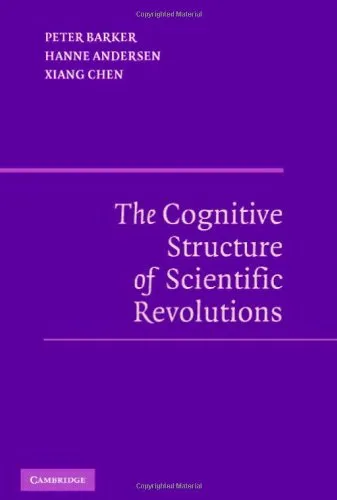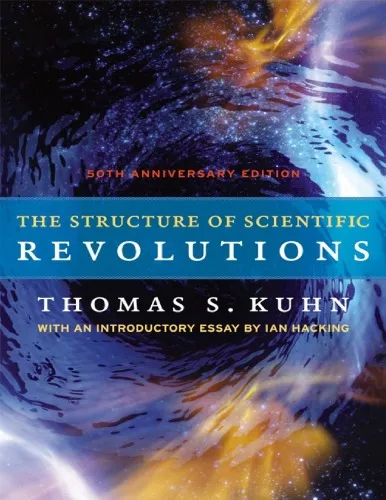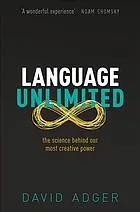The Cognitive Structure of Scientific Revolutions
4.6
بر اساس نظر کاربران

شما میتونید سوالاتتون در باره کتاب رو از هوش مصنوعیش بعد از ورود بپرسید
هر دانلود یا پرسش از هوش مصنوعی 2 امتیاز لازم دارد، برای بدست آوردن امتیاز رایگان، به صفحه ی راهنمای امتیازات سر بزنید و یک سری کار ارزشمند انجام بدینکتاب های مرتبط:
مقدمهای بر کتاب 'The Cognitive Structure of Scientific Revolutions'
کتاب 'The Cognitive Structure of Scientific Revolutions' اثری است که توسط 'هانه اندرسن، پیتر بارکر و شیانگ چن' نگاشته شده و به بررسی ساختار شناختی انقلابهای علمی میپردازد. این اثر تلاش میکند تا با نگاهی نو به نظریات توماس کوهن در مورد پارادایمهای علمی و تغییرات آنها، دیدگاههای جدیدی را به مخاطبان ارائه دهد.
خلاصهای مفصل از کتاب
کتاب 'The Cognitive Structure of Scientific Revolutions' به دنبال بازتعریف و گسترش نظریه انقلابهای علمی کوهن است. نویسندگان با تمرکز بر جنبههای شناختی و ذهنی که باعث تغییرات علمی میشوند، میکوشند تا به چگونگی شکلگیری و تحول ایدههای علمی بپردازند. از جمله موضوعاتی که در این کتاب بررسی میشوند، میتوان به ساختار علمی، فرآیندهای شناختی دانشمندان و تعامل میان تجربه و تئوریها اشاره کرد. این کتاب با ترکیب روشهای مختلف و تحلیلهای میانرشتهای، تصویری جامع از فرآیندهای تفکر علمی ارائه میدهد.
نکات کلیدی
- بازاندیشی در نظریه کوهن در خصوص پارادایمها و نقش آنها در پیشبرد علم.
- بررسی دقیقتر از نحوه تغییرات پارادایمی و تأثیر شناختی آن بر جامعه علمی.
- ترکیب دیدگاههای فلسفی، تاریخ علم و روانشناسی شناختی برای تحلیل انقلابهای علمی.
- شناخت بهتر فرآیندهای ذهنی و شناختی که در پس تصمیمگیریهای علمی نهفتهاند.
نقلقولهای معروف از کتاب
"درک منظور کوهن از انقلابهای علمی تنها از طریق فهم تغییرات شناختی امکانپذیر است که در ذهن دانشمندان و همچنین جامعه علمی رخ میدهد."
"پارادایمها همچون نقشههایی هستند که دانشمندان به کمک آنها در سرزمین ناشناخته علم حرکت میکنند."
چرا این کتاب مهم است؟
این کتاب با ارائه نگاهی نوین به نظریه مشهور کوهن، به رفع برخی از نقدها و ابهامات پیرامون آن کمک میکند. با تحلیل عمیق مسائل شناختی و روانشناسی در فرآیندهای علمی، نویسندگان نه تنها برای پژوهشگران فلسفه و تاریخ علم، بلکه برای تمامی علاقهمندان به مبانی و مسیرهای تحول علم، محتوای ارزندهای فراهم آوردهاند. بررسی این کتاب باعث میشود تا درک بیشتری از تعامل بین ذهن انسان و جهان علمی بهدست آوریم که میتواند اثرات گستردهای بر تحقیقات آینده و جهتهای فکری جدید داشته باشد.
Introduction to 'The Cognitive Structure of Scientific Revolutions'
The fusion of philosophical inquiry and cognitive science has exposed rich, nuanced insights about the nature of scientific change. 'The Cognitive Structure of Scientific Revolutions' compels readers to rethink classic narratives about how scientific paradigms evolve and transform.
Detailed Summary of the Book
Building upon the foundational theories introduced by Thomas Kuhn, 'The Cognitive Structure of Scientific Revolutions' delves into the intricate cognitive processes that underpin scientific shifts. Unlike traditional perspectives that view paradigm shifts primarily as social phenomena, this book investigates the underlying cognitive structures that facilitate or impede these transformations. It examines how scientists' mental frameworks, conceptual change, and cognitive limitations influence the trajectory of scientific thought.
Through meticulous analysis, the authors explore the interplay between individual cognitive capacities and collective scientific advancements. They illuminate how factors such as analogy, similarity, and categorization contribute to the gradual or abrupt reshaping of scientific paradigms. The work underscores the importance of cognitive diversity in fostering scientific innovation, as well as the role of cognitive biases in sustaining obsolete paradigms.
Key Takeaways
- Cognitive science offers crucial insights into the nature of scientific knowledge and its evolution over time.
- Scientific revolutions are deeply interwoven with cognitive processes such as analogy and categorization rather than being solely social or historical events.
- Diverse cognitive approaches among scientists can lead to more robust scientific inquiry and breakthroughs.
- Recognizing cognitive biases in scientific communities can aid in overcoming entrenched paradigms that may hinder progress.
Famous Quotes from the Book
“By exploring the cognitive landscapes of scientists, we unravel the mental terrain where revolutionary thoughts are born.”
“Cognitive plurality, much like biodiversity in nature, strengthens the ecosystem of scientific thought.”
Why This Book Matters
In today's rapidly evolving scientific environment, 'The Cognitive Structure of Scientific Revolutions' stands as a pivotal contribution that bridges the gap between philosophical theory and cognitive science. It challenges traditional paradigms and encourages reevaluation of the mechanisms driving scientific progress. By foregrounding the cognitive aspects of scientific practice, this book not only deepens our understanding of past scientific revolutions but also equips us with tools to better navigate future ones.
For scientists, philosophers, and educators alike, this work offers a transformative perspective on the engines of scientific change. Its emphasis on cognitive processes provides valuable insights into how breakthroughs can be nurtured and sustained, ultimately advancing the collective knowledge of our world.
دانلود رایگان مستقیم
شما میتونید سوالاتتون در باره کتاب رو از هوش مصنوعیش بعد از ورود بپرسید
دسترسی به کتابها از طریق پلتفرمهای قانونی و کتابخانههای عمومی نه تنها از حقوق نویسندگان و ناشران حمایت میکند، بلکه به پایداری فرهنگ کتابخوانی نیز کمک میرساند. پیش از دانلود، لحظهای به بررسی این گزینهها فکر کنید.
این کتاب رو در پلتفرم های دیگه ببینید
WorldCat به شما کمک میکنه تا کتاب ها رو در کتابخانه های سراسر دنیا پیدا کنید
امتیازها، نظرات تخصصی و صحبت ها درباره کتاب را در Goodreads ببینید
کتابهای کمیاب یا دست دوم را در AbeBooks پیدا کنید و بخرید
1274
بازدید4.6
امتیاز0
نظر98%
رضایتنظرات:
4.6
بر اساس 0 نظر کاربران
Questions & Answers
Ask questions about this book or help others by answering
No questions yet. Be the first to ask!















